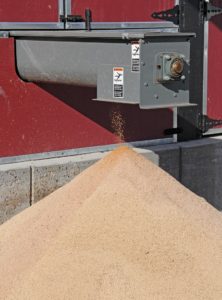Olive Oil Production By-Product for Food
Potential Use of Olive Oil Waste for Novel Food Product Development Dr. Y. Olive Li College of Agriculture at Cal Poly Pomona
Authors: Ann Sievers Owner IL Fiorello Olive Oil Co and Dr. Y. Olive Li College of Agriculture at Cal Poly Pomona
Did you know that 35 lbs. to 40 lbs. of olives (depending on the variety) makes about a liter of olive oil? The product is very dear and very expensive. Also it is very good for you. If you find an inexpensive oil it probably is not olive oil, but a mixture of vegetable oil (highly refined by chemicals and heat) and olive oil. Look for the third party certification in California olive oils to insure quality.

Another huge issue for olive millers is the environmental burden of olive waste. This is the post production material. Approximately 80% to 85% of the olive is post extraction residue which includes pits (wood kernels), olive skin, tissue of the olive, and water. So the question becomes what to do with this product.
Dr. Y. Olive Li, a Professor at Cal Poly Pomona, may have a very interesting answer. Dr. Li is in the Department of Human Nutrition and Food Science, College of Agriculture at Cal Poly Pomona. Her research is sponsored by Cal Poly Pomona ARI Research Grant (2014, #003570) and a SCIFTS Education and Research Grant (2014). She and her colleagues (see attached poster presentation for reference) analyzed the post-extraction olive pomace. It is rich in polyphenols, flavonoids, antioxidants, dietary fibers and protein. Sounds like a great product. She says this is a very promising source of various nutraceuticals for development of novel functional foods.
Dr. Olive Li visited IL Fiorello, white coat flying in the wind, with enough energy to run our solar power system by herself. Her goal was to reach deep into the olive waste pomace to get truly good samples. Our goal was not to let her fall in given her enthusiasm! We had a marvelous day talking about human nutrition, milling olives, and how the machines to extract oil actually work. She is a fountain of information and energy.
Dr. Li and her team undertook an exploration of how to use this byproduct by incorporating olive pomace in cereal grain flours. The goal was to convert the wet pomace to a shelf-stable powder ingredient that can be incorporated with other grains to be used for staple foods such as pasta and bakery goods. The final product has a higher nutrient content than just single grain products. Maybe the use of olive by-products in human nutrition can be a multi-level solution for improved human nutrition, (and animals), and assist with environmental concerns.
In the sensory tests, all the different cereal products combined with the olive pomace resulted in acceptable pasta products, and the whole wheat formulation was the most preferred by the sensory panel.
The olive industry will definitely benefit from her research. Il Fiorello benefits by providing pomace for her research and knowing that great things will come from our collaboration. Maybe we will be able to serve pasta, made with our by-products, and finish it with our oils, a complete presentation.
